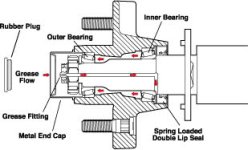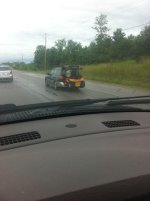You are using an out of date browser. It may not display this or other websites correctly.
You should upgrade or use an alternative browser.
You should upgrade or use an alternative browser.
Share Pics of People Hauling or Towing Something Wrong
- Thread starter 94BULLITT
- Start date
- Views: 5069126
More options
Who Replied?
/ Share Pics of People Hauling or Towing Something Wrong
#5,241
downsizingnow48
Elite Member
I never pulled a hub on any of those trailers.
Here is a diagram that shows how the ez lube hub works. The grease goes in through the middle of the hub, then comes out through the inner bearing, and then finally through the outer bearing.
To grease it, I raise the tire off the ground, spin slowly with left hand, grease with manual pistol grip gun in the right hand. With dust cap off you can see when the new grease comes through the outer bearing. It can't get there without going through the inner bearing first.
The key is to spin the tire and grease slowly with a manual gun so that the grease has a chance to move through the whole inner bearing then the whole outer bearing. Without putting excess pressure on the seal.
Here is a diagram that shows how the ez lube hub works. The grease goes in through the middle of the hub, then comes out through the inner bearing, and then finally through the outer bearing.
To grease it, I raise the tire off the ground, spin slowly with left hand, grease with manual pistol grip gun in the right hand. With dust cap off you can see when the new grease comes through the outer bearing. It can't get there without going through the inner bearing first.
The key is to spin the tire and grease slowly with a manual gun so that the grease has a chance to move through the whole inner bearing then the whole outer bearing. Without putting excess pressure on the seal.
Attachments
Redlands Okie
Veteran Member
Plus one on the spinning the wheel, i should have mentioned that also. Yay downsizingnow48 

Pflum
New member
Just started looking at this thread, on page 12. Keep expecting one of my loads to show up on here.
TomSeller
Super Member
Get that thing ripping down a hill, and it'll recharge the batteries!!! Wait... Right??
IF he can get to the top of the hill
LD48750
Veteran Member
I have had ez-lube hubs on 5 trailers over the last 15 years or so. 2 Haulmark, 1 Kaufman, 1 PJ, and the current LoadTrail. Never a problem of blown seals, greasy brakes, or anything else. Not hard to get it right either. I just read and followed the axle manufacturer's instructions.
Did someone take away your Man Card for reading the instructions?
downsizingnow48
Elite Member
I know, I should get at least a two week suspension.
I volunteered to drive the band trailer for the high school a few years ago, and the trailer was loaned by a former band parent. When I picked it up from his house, he assured me he just checked tire pressure, greased the hubs, etc. He handed me a small tub of grease and said "just pop those off and smear the grease there" as he pointed to the rubber plugs. Hmmm. I got it home, and checked for myself. Ssure enough he had popped off the rubber plugs and packed the area full of grease, right over the axle nut and zerk. They were ez lube hubs but apparently he didn't know what a grease fitting was or how to properly pull the hub to grease it 'old school'. When we pulled the hubs to check them, it was obvious the hadn't been lubed in years. Oh, and the tires had under 20 lbs of pressure. I went over everything on it after that, bringing it up to safe standards for him (for the school really). It makes me think about how other trailers are maintained when I see them on the road.I never pulled a hub on any of those trailers.
Here is a diagram that shows how the ez lube hub works. The grease goes in through the middle of the hub, then comes out through the inner bearing, and then finally through the outer bearing.
To grease it, I raise the tire off the ground, spin slowly with left hand, grease with manual pistol grip gun in the right hand. With dust cap off you can see when the new grease comes through the outer bearing. It can't get there without going through the inner bearing first.
The key is to spin the tire and grease slowly with a manual gun so that the grease has a chance to move through the whole inner bearing then the whole outer bearing. Without putting excess pressure on the seal.

